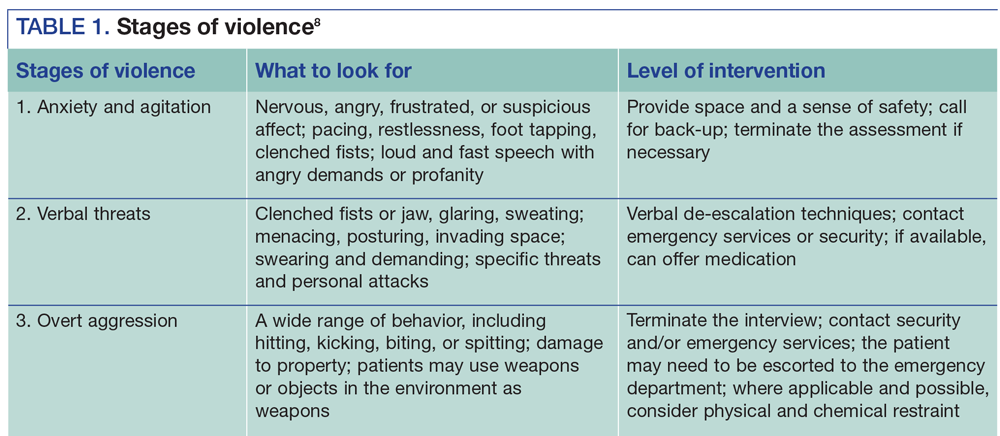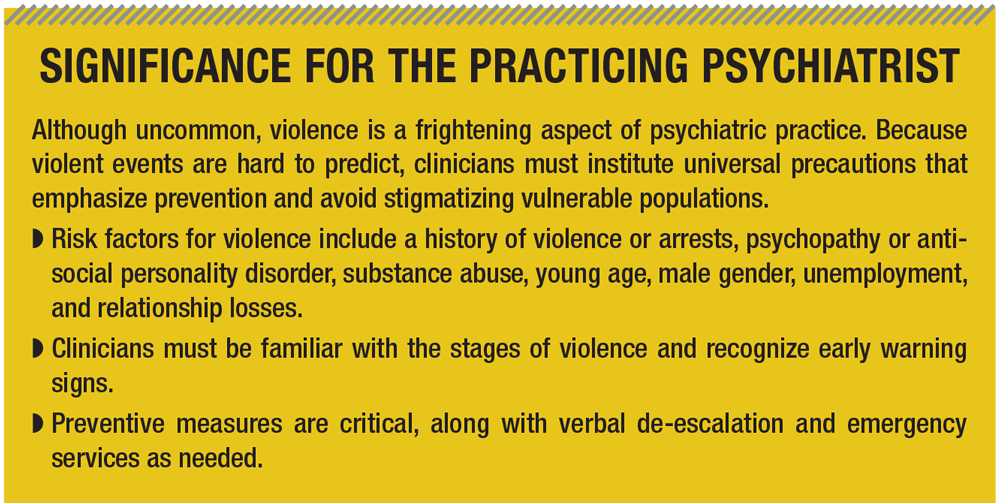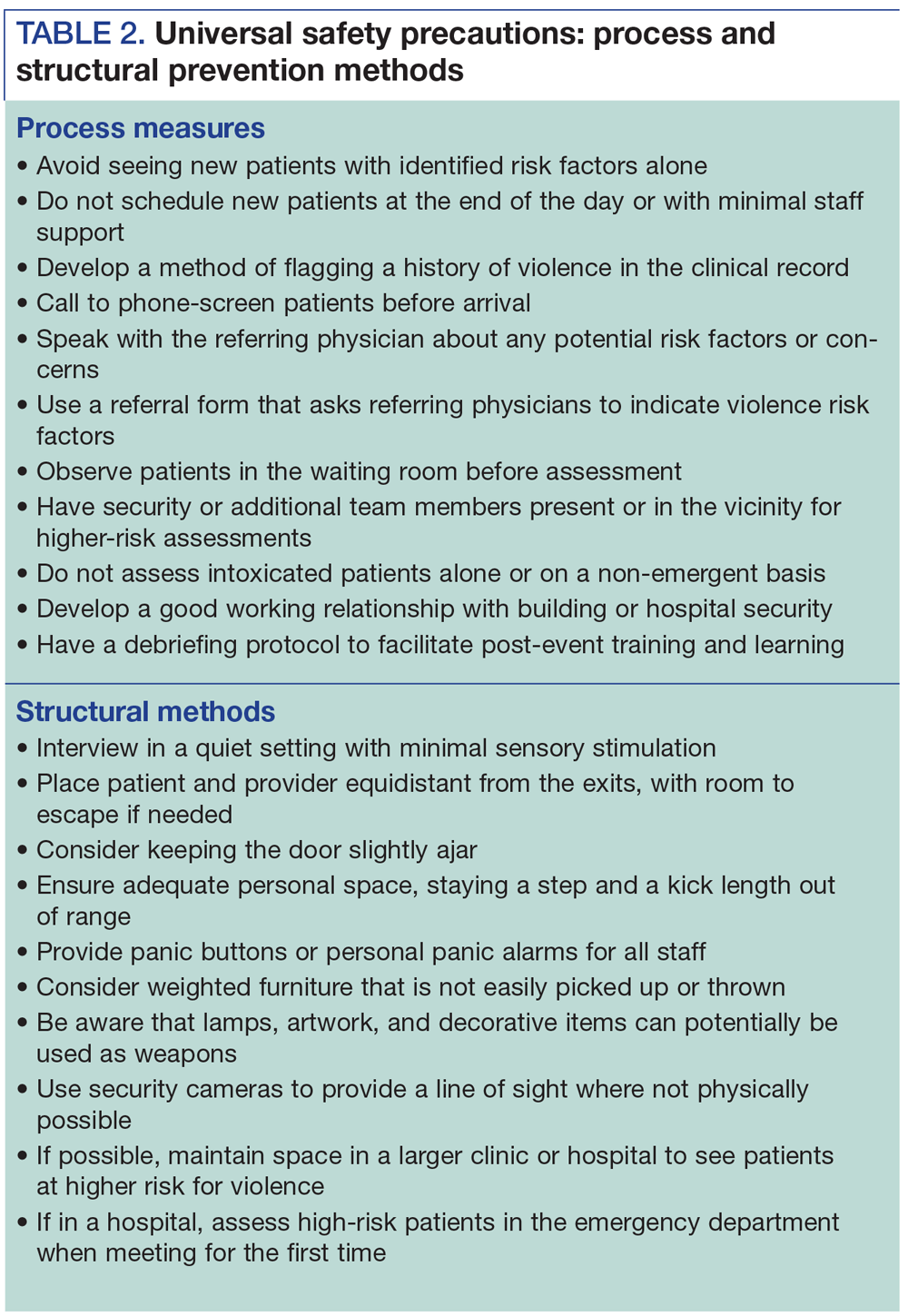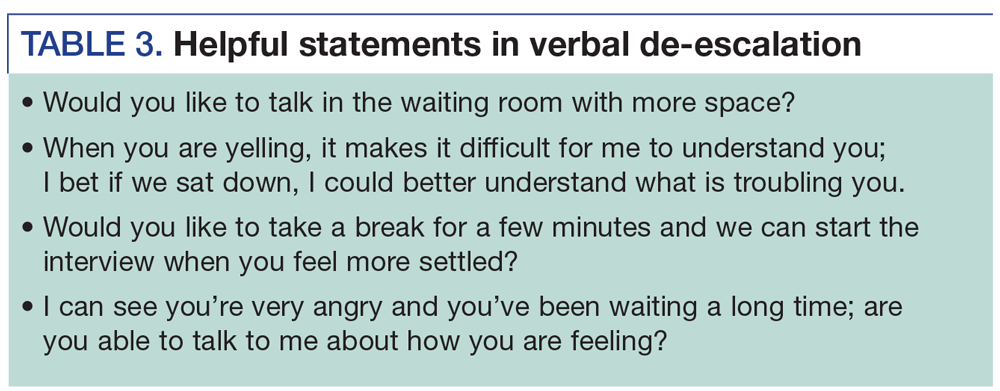
How could this have happened? What could you do to keep yourself and your team safe from another code white?
TABLE 1. Stages of violence

SIGNIFICANCE FOR THE PRACTICING PSYCHIATRIST

TABLE 2. Universal safety precautions: process and structural prevention methods

TABLE 3. Helpful statements in verbal de-escalation

It had been a long week, and there was only one new consult standing between now and the upcoming call-free weekend. Dr. Taylor didn’t usually see new consults on a Friday afternoon, but an urgent request from a colleague had piqued his interest, and having a resident around for the assessment made it all too easy. Handing over the faxed referral to the eager and capable learner, he got to work reviewing the day’s cases.
Twenty minutes later, Dr. Taylor heard a loud thump and a yell from down the hall. Springing to his feet, he dashed to the door to see the clinic administrative assistant rushing across the waiting room with a look of panic on her face. A scream echoed from the consult room, along with the rumble of furniture dragging across the tiled floor. Fear gripped his chest as he realized what was happening, and he shouted for someone to call a code white.
Thoughts raced through his mind: what should he do? How could this have happened? What could he do to keep himself and his team safe?
In medicine, safety is paramount. As a specialty, psychiatry seeks to help those experiencing extreme psychological distress and vulnerability. Although providers may be hopeful and well intentioned in their clinical encounters, violence against health care professionals is an unfortunate and disturbing reality. A survey of American psychiatry residents indicated that 25% had been physically assaulted by a patient at some point in their training. Rates of threats and physical intimidation reached 86% and 71%, respectively. 1
Providers might anticipate violence in the emergency department or an inpatient setting, but violence can occur anywhere. Among outpatients with severe and persistent mental illness, 2% to 13% had perpetrated violence in the community in the past 6 months to 3 years. 2 Although violent attacks in outpatient settings are less common, recently publicized violent episodes highlight the importance of office safety strategies to keep patients and providers safe. 3
Understanding risk factors
An appreciation of how risk factors interact is key to understanding and predicting violent behavior in people with mental illness. Having a mood or psychotic disorder carries only a small increased risk of violence compared with the general population but when combined with a history of substance abuse, personal victimization, or exposure to violence in the surrounding environment, the likelihood of violence increases. 4 Risk factors for violence include a history of violence or arrests, psychopathy or antisocial personality disorder, substance abuse, young age, male gender, unemployment, and relationship losses. 5
Risk assessment tools vary from unstructured approaches based on intuition to validated actuarial tools weighed to an explicit algorithm. Clinicians who receive referrals in the outpatient setting may not have the information necessary to make an accurate prediction of risk using an actuarial tool. In addition, there are no tools that can routinely predict in-office violence, and a clinical gestalt may not suffice. Accordingly, universal precautions and preventive measures must be applied in all clinical settings.
When clinicians work without ready access to a security team or environmental safety features, it is important to employ a standard process and screening tools to appropriately triage and anticipate violence. Clinicians who work alone, or who see patients after hours and on weekends, are particularly vulnerable.
Kendra, the 2nd-year resident on her community psychiatry rotation with Dr. Taylor, was eager to wrap up the day’s work and drive back to the city for the weekend. Feeling comfortable with her newly developed assessment skills, she quickly reviewed the referral letter while calling the patient into the consult room. Twenty-three-year-old Mark had recently been discharged from the local hospital’s inpatient psychiatry unit, where he had been referred for follow-up and diagnostic clarification regarding a primary psychotic disorder or substance-induced psychosis. In the waiting area, Mark appeared nervous, rapidly tapping his feet and glancing around the empty room.
Prevention
Early recognition of agitation is crucial to preventing or avoiding escalating behavior problems. Table 1 outlines the stages of violence and the levels of intervention required. Noticing early warning signs such as pacing and frustrated affect can avoid danger and allows an opportunity to help patients feel safe and stay in control.
Prevention can be subdivided into structural and process measures, with some overlap. From a process perspective, balancing the need to screen for violence with practical clinical reality can be difficult. Being aware of the potential for violence and building in automatic steps to mitigate that risk is a good place to start.
Ask the referring provider to indicate any history of violence or concerns about seeing the patient alone. Connect with the referring physician to discuss any concerns. For patients with a known or suspected history of violence, consider a brief phone screening tool before seeing the patient in an office setting, particularly in a private or home-office environment. Flagging a history of violence in the clinical record alerts other providers who may interact with the patient in the future.
Before and during the assessment, review the referral and any available clinical records to assess the level of risk. Whenever possible, observe the patient before the assessment and interview patients in a larger space when there are clinical concerns or multiple risk factors for violence. Recognize that many patients have had personal experiences of abuse or violent victimization. Maintaining a trauma-informed perspective and awareness of this disturbing reality can help patients feel dignified and respected in a time of personal crisis. Trauma-informed services acknowledge the prevalence and impact of trauma, and prioritize patient safety, choice, and control. 6
The goal of universal precautions is to keep patients and providers safe. Table 2 highlights recommendations for process and structural prevention methods.
Management
When prevention fails, clinicians can use verbal strategies to de-escalate patients in distress. Verbal de-escalation involves validating a patient’s experience, establishing a collaborative relationship, and finding solutions to ensure the patient’s needs are met. Project BETA (Best Practices in Evaluation and Treatment of Agitation) developed consensus principles for verbal de-escalation that include identifying wants and feelings, listening to what the patient is saying, and respecting personal space. Clinicians should set firm boundaries and limits but offer choices and optimism. Modulating one’s tone of voice and using a reassuring, respectful, and nonjudgmental approach can help a patient maintain an internal locus of control.
Common mistakes in verbal de-escalation include arguing or taking the emotional state personally. Instructing a patient to “calm down” or falsely threatening to call security or police is generally unhelpful and can increase the acuity of the situation. Table 3 highlights some practical statements that can be used in verbal de-escalation.
These techniques can be helpful in reducing agitation or allowing more time for security or police to arrive. To facilitate this, some method of indicating distress, through a panic button or coded distress phrase, is helpful in alerting colleagues to call for external support or attend to the situation. Importantly, verbal de-escalation techniques must be learned and practiced in order to be implemented effectively.
A workplace violence survey highlighted the need for multidisciplinary team safety training and the value of standardized protocols for post-incident debriefing and processing. 7 Mandating routine crisis intervention and safety training for all team members will underscore the importance of violence prevention from an organizational perspective. For worst-case scenarios, teams must be well-acquainted with local safety and security protocols, including calling for emergency services through a “code white” or 911 call. Physicians who work in an independent location may benefit from a security consultation through a local provider.
During Kendra’s assessment, it became clear that Mark was intoxicated and experiencing auditory hallucinations. He became upset in the small space and threw a chair against the wall, which caused Kendra to scream and press her personal panic alarm. Fortunately for Dr. Taylor’s team, Kendra used verbal de-escalation techniques and ascertained that Mark was feeling unsafe in the small interview room. She dragged the chair away from the door, allowing both to exit to the waiting area safely. Hospital security arrived quickly to provide a supportive presence. Though shaken, no one was physically harmed, and Mark was escorted to the emergency department for further assessment. The clinic reviewed its violence prevention strategy and reached out to colleagues at another city site to share best practices.
Debriefing
Determining the next steps after an incident of workplace violence can be complex and emotionally challenging. Immediately, teams should support those involved and enable access to appropriate medical and psychiatric care. A post-incident debriefing should provide a safe venue to review the incident, which fosters an understanding of both factual events and emotional responses. Practically, understanding what occurred can help organizations learn how to prevent similar events in the future. Preventing, managing, and dealing with workplace aggression should be the responsibility of both employees and employers.
On a personal level, reactions to an episode of violence can be complex and counterintuitive. Providers report increased anxiety about being in similar situations or assessing similar patients, as well as displacement of fear and anger onto patients with similar characteristics. Paradoxically, a counterphobic reaction may develop, in which providers may take on extra calls, interview potentially dangerous patients alone, and downplay the need for assistance and backup. Reactions may be delayed and occur months later, and providers should talk to supervisors, staff teams, colleagues, and treating teams to explore their experiences and feel less alone. A study of psychiatric nurses indicated that there is a need for specialized services and follow-up support to help with the serious negative impact of assault on health care providers. 8
Seeking criminal prosecution is a personal and complicated decision. It may be beneficial to discuss the decision with colleagues to ensure objectivity is maintained. Refraining from pressing charges may not always be the ethical choice.
Summary
The risk of violence in psychiatric practice is a frightening aspect of our work. Violent events are uncommon and hard to predict, and clinicians must guard against complacency and institute universal precautions that emphasize prevention. Patients with mental illness are at high risk for violent victimization, and preventive measures should not stigmatize a vulnerable population. Team members must work together to optimize safety, using evidence and experience to ensure excellent patient care.
MORE ABOUT Jodi Lofchy, MD
Dr. Lofchy is currently the Director of Psychiatry Emergency Services at the University Health Network in Toronto and Associate Professor at the University of Toronto. After receiving her medical degree from the University of Toronto, she completed her training in Vancouver, BC, and practiced as a general practitioner before returning to Toronto to undertake the residency program in Psychiatry. This was followed by a 2-year Fellowship in Emergency Psychiatry at the Clarke Institute of Psychiatry, where she was subsequently appointed Director of Emergency Services. She has been with the University Health Network since 2002 and helped create a model of best practice in Emergency Psychiatry with the development of the service and emergency holding unit.
Dr. Lofchy continues to be involved in the development of formal teaching programs in Emergency Psychiatry and has assisted other universities in the creation of similar programs. Her writing focuses on innovations in emergency education and medical education.
Her love of drama and adventure in the clinical setting-the world of Emergency Psychiatry-has translated into activities she enjoys in her time away from work: high-altitude trekking, exotic cycling trips, and exploring far-flung parts of the world. She notes that all help to keep the energy fresh while at work. When in Toronto, she recharges with Roxy, her miniature apricot poodle, whose feisty nature is a constant joy to her.
MORE ABOUT Bruce Fage, MD
Dr. Fage is a Psychiatry Resident at the University of Toronto and Chief Resident at the Center for Addiction and Mental Health, Canada’s largest mental health and addictions teaching hospital. As Vice-President of the Professional Association of Residents of Ontario (PARO), he advocates for optimal training and working conditions for residents across the province.
Dr. Fage is helping to oversee the implementation of competency-based medical education at the University of Toronto Department of Psychiatry and is advocating for a postgraduate training program that can meet the mental health needs of the Canadian health care system. He is passionate about improving psychiatric care and practice and is a Fellow of the Group for the Advancement of Psychiatry, a professional organization of psychiatrists dedicated to shaping psychiatric thinking, public programs, and clinical practice in mental health. He has written about emergency psychiatry and physician mental health for CanadiEM.org and is a founding member of PsychEd, a psychiatry podcast for medical learners.
Outside of medicine, he enjoys playing the trombone, running, and going home to Nova Scotia. Occasionally, he can be found coaching his dog Gigi through Toronto’s canine fashion circuit. Follow @FageMD.
Dr. Lofchy is Director, Psychiatry Emergency Services, University Health Network, Department of Psychiatry; and Associate Professor, University of Toronto, Canada. Dr. Fage is a Third-Year Psychiatry Resident, University of Toronto.
The authors report no conflicts of interest concerning the subject matter of this article.
1. Dvir Y, Moniwa E, Crisp-Han H, et al. Survey of threats and assaults by patients on psychiatry residents. Acad Psychiatry. 2012;3:39-42.
2. Choe JY, Teplin LA, Abram KM. Perpetration of violence, violent victimization, and severe mental illness: balancing public health concerns. Psychiatr Serv. 2008;59:153-164.
3. Kaplan A. Violent attacks by patients: prevention and self-protection. Psychiatric Times. 2008;25(7):5.
4. Swanson JW. Preventing the unpredicted: managing violence risk in mental health care. Psychiatr Serv. 2008;59:191-193
5. Elbogen EB, Johnson SC. The intricate link between violence and mental disorder: results from the National Epidemiologic Survey on Alcohol and Related Conditions. Arch Gen Psychiatry. 2009;66:152-161.
6. Poole N, Greaves L. Becoming Trauma Informed. Toronto, ON: Center for Addiction and Mental Health; 2012.
7. Privitera M, Weisman R, Cerulli C, et al. Violence toward mental health staff and safety in the work environment. Occup Med. 2005;55:480-486.
8. Moylan LB, McManus M, Cullinan M, Persico L. Need for specialized support services for nurse victims of physical assault by psychiatric patients. Issues Ment Health Nurs. 2016;37:446-450.
9. Lofchy JS. Emergency assessment. In: Goldbloom DS, ed. Psychiatric Clinic Skills. Revised 1st ed. Toronto, ON: Center for Addiction and Mental Health; 2009.